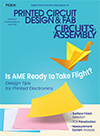Features Articles
 "Non-standard" head shapes mean flex circuits are a given.
"Non-standard" head shapes mean flex circuits are a given.
We've come a long way in the AR/VR space. It seems like we're going to have this stuff whether we want it at the moment or not. It's kind of like the Northwest Passage through the ice cap. It's new. We're not sure what the result looks like, but we're charging ahead with a virtual and/or augmented future.
Set the wayback machine to 1939, when both my father and the View-Master stereoscope entered the room. This wasn't long after Kodachrome was invented, so it was cutting-edge at the time. We put circular cards into the slot and could browse seven different views that somehow tricked the eye into seeing depth from isolating each eye on two similar slides (Figure 1).
Back in "real" reality, this technology still has a lot of room to grow. It was about a decade ago when virtual reality started to bubble up into the lexicon at Google. We knew that a new industry was coming into existence and wanted to at least provide a gateway to the content. A group adjacent to the Chrome team developed a product called "Cardboard" that reminded me of the View-Master.
 While the 5G era continues to take hold, materials science must advance for us to move to the next stage.
While the 5G era continues to take hold, materials science must advance for us to move to the next stage.
It's part of the human condition to never be satisfied. We are always looking forward to what comes next, and this tendency is starkly evident in our attitudes toward technology. As our daily lives have become substantially enabled, empowered, and – many would probably agree – enhanced by the technology in our pockets, in our cars, and in our homes and offices, we have become increasingly demanding of more and better. More features and functions, more sophistication, faster responses, less waiting.
Our attitudes toward mobile services illustrate the point. No sooner had 5G networks started rolling out than the focus shifted to 6G and the exciting new opportunities it could bring. But is this a harsh truth about our nature, or simply the reality of a massive scientific and engineering challenge? The mobile industry has established a rhythm that introduces a new generation about once every 10 years: 3G arrived around 2000, 4G-LTE in 2010, and 5G rollouts based on Release 15 of the 3GPP specification began around 2020. 5G evolution has continued, with non-standalone deployments giving way to standalone 5G core and further enhancements in 3GPP Release 16 and 17 to support industrial IoT (IIoT) applications. Release 18 now paves the way for 5G Advanced, which will offer energy savings and greater spectral efficiency, leverage AI to improve network performance, and, of course, enable additional new services and enhanced capabilities.
 Leveraging additive manufacturing technology to mistake-proof production.
Leveraging additive manufacturing technology to mistake-proof production.
One thing OEMs universally agree on is that none of them likes non-recurring engineering (NRE) charges. Implemented as part of new product introduction (NPI), however, custom tooling, fixtures and jigs can eliminate defect opportunities by minimizing process variation that could otherwise occur when those issues can’t be resolved through product design changes. They are also a good tool when a production team identifies the need for a poka-yoke, or mistake-proofing solution, later in a product’s lifecycle.
The concept of poka-yoke was developed by Shigeo Shingo as part of the Toyota Production System (TPS). When applied, the resulting process improvement eliminates a specific defect. Its focus on simplicity is its strength, in that simple fixes are often the best solution for small variances in the manufacturing process. Simple fixes are also easy to rapidly implement and encourage production operator involvement in the pursuit of product perfection. That said, when fixtures are procured through third parties, the cost may exceed the benefit.
 Relocating manufacturing to the West requires more than moving factories.
Relocating manufacturing to the West requires more than moving factories.
For much of the past decade, many have touted the reshoring of electronics and especially printed circuit boards and electronic assemblies. Many reasons have been cited as to why reshoring is now taking place, from supply chain difficulties to nationalism, to the marketing optics of where products are made.
Indeed, no matter where you are from, it is always a nice feeling to buy locally, and while supply chain issues have been a serious problem over the past few years thanks in large part to tariffs and Covid, these challenges have seemed to impact all parts of the world relatively similarly. Because – or despite – these desires and challenges, the rate of reshoring, as measured by employment expansion, has been escalating, with the estimated annual number of jobs created attributed to reshoring topping 350,000 in the US alone.
That said, the challenges in successfully reshoring are still significant and basing success purely on employment levels may be misleading. Looking at the challenges, there have always been four: capital, facilities, technology and people, with now the possible addition of a fifth, inflation, to contend with. And two on the list may end up putting a cap on reshoring, at least in certain industries.
To close the gap in IC substrates, buyers need skin in the game.
 The CHIPS Act was passed more than a year ago and not one federal dollar has yet to be awarded – although private industry has committed and started to spend billions. Once funded, the new, more advanced foundries will take years to build and start operations.
The CHIPS Act was passed more than a year ago and not one federal dollar has yet to be awarded – although private industry has committed and started to spend billions. Once funded, the new, more advanced foundries will take years to build and start operations.
When produced, however, the chips will be useless until they are packaged and mounted on PCB platforms. The facilities, materials and knowhow to produce the substrates used to package them remain primarily in Asia – including China.
Notably, the cost to build and equip the necessary substrate and PCB facilities to produce HDI and UHDI (ultra-HDI) circuitry in volume is substantially more than that of a typical PCB or flex circuit factory, but far less than that needed for a foundry.
To provide incentives, US Representatives Blake Moore (R-UT) and Anna Eshoo (D-CA) this year introduced H.R.3249 – Protecting Circuit Boards and Substrates Act. This bill is the second iteration of this effort and has a long way to go in gaining cosponsors and approval.
Creating sustainable Western PCB and substrate sources will take time, and will not necessarily be in the country of use. Today just a handful of American and Western companies have the technology to produce some level of UHDI circuitry. To develop a secure source, the US will need more than government words, resolutions, bills and funds with heavy ropes (not just strings) attached: It needs active OEM investment and participation.
 Are your internal processes or actions creating bad word of mouth?
Are your internal processes or actions creating bad word of mouth?
Years ago, I went to a communications conference in Chicago where a Japanese quality executive discussed the reason behind Japanese companies' relentless pursuit of quality. He said it all boiled down to word of mouth. Japan's cities are densely populated. Residents use mass transit and live in apartment complexes. This executive said their studies had found that when a domestic consumer had a bad experience, they were likely to tell at least 10 people on their way home from work. Having lived in Japan, I agree with that assessment and that imagery remains in the back of my mind.
The internet has exacerbated this phenomenon. Recently, I had a client who was looking for lead database options. Other clients had said good things about a database they were using, so I did a search and came up with two options: the one with positive word of mouth and a much cheaper option with good online reviews. The first vendor I contacted required watching a demo to obtain pricing and details. Their salesperson ultimately discounted the annual price based on the low volume lead search needs of my client.
The second vendor shared pricing info and service descriptions on its website, no demo required.
Press Releases
- KIC Expands Footprint in Mexico to Deliver Faster, Localized Support
- ECIA Executive Conference Announces Session on eCrime Tradecraft
- ICZOOM Group Inc. Announced the Launch of PCB & SMT Services to Strengthen One-Stop Electronics Industry Solution at IIC Shenzhen 2025
- Amtech Unveils Proprietary Automation Model for High-Mix, Low-Volume Manufacturing


